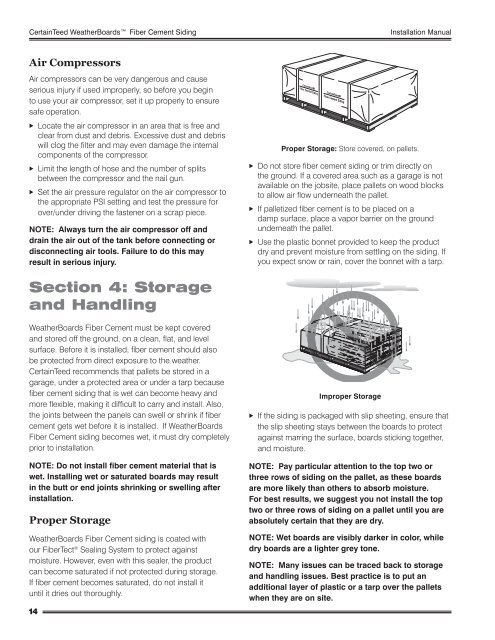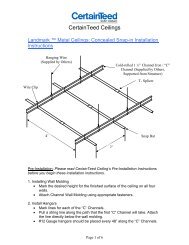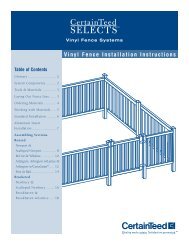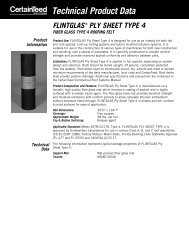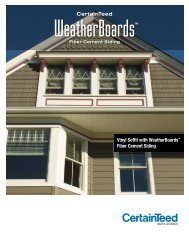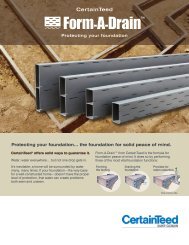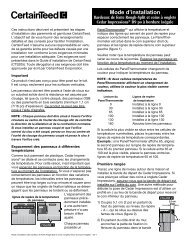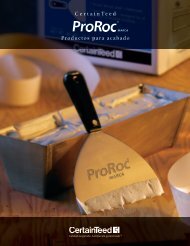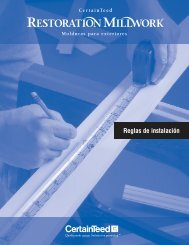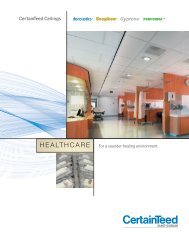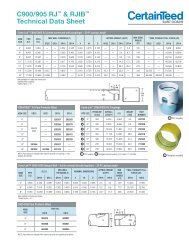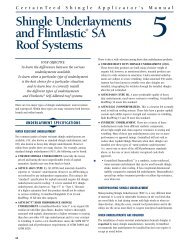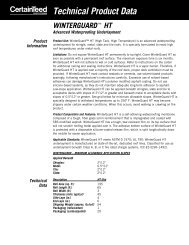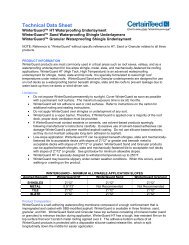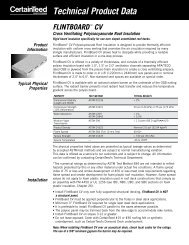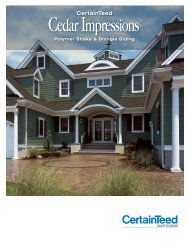Installation Manual - CertainTeed
Installation Manual - CertainTeed
Installation Manual - CertainTeed
You also want an ePaper? Increase the reach of your titles
YUMPU automatically turns print PDFs into web optimized ePapers that Google loves.
<strong>CertainTeed</strong> WeatherBoards Fiber Cement Siding <strong>Installation</strong> <strong>Manual</strong><br />
Air Compressors<br />
Air compressors can be very dangerous and cause<br />
serious injury if used improperly, so before you begin<br />
to use your air compressor, set it up properly to ensure<br />
safe operation.<br />
XXLocate the air compressor in an area that is free and<br />
clear from dust and debris. Excessive dust and debris<br />
will clog the filter and may even damage the internal<br />
components of the compressor.<br />
XXLimit the length of hose and the number of splits<br />
between the compressor and the nail gun.<br />
XXSet the air pressure regulator on the air compressor to<br />
the appropriate PSI setting and test the pressure for<br />
over/under driving the fastener on a scrap piece.<br />
NOTE: Always turn the air compressor off and<br />
drain the air out of the tank before connecting or<br />
disconnecting air tools. Failure to do this may<br />
result in serious injury.<br />
Section 4: Storage<br />
and Handling<br />
WeatherBoards Fiber Cement must be kept covered<br />
and stored off the ground, on a clean, flat, and level<br />
surface. Before it is installed, fiber cement should also<br />
be protected from direct exposure to the weather.<br />
<strong>CertainTeed</strong> recommends that pallets be stored in a<br />
garage, under a protected area or under a tarp because<br />
fiber cement siding that is wet can become heavy and<br />
more flexible, making it difficult to carry and install. Also,<br />
the joints between the panels can swell or shrink if fiber<br />
cement gets wet before it is installed. If WeatherBoards<br />
Fiber Cement siding becomes wet, it must dry completely<br />
prior to installation.<br />
NOTE: Do not install fiber cement material that is<br />
wet. Installing wet or saturated boards may result<br />
in the butt or end joints shrinking or swelling after<br />
installation.<br />
Proper Storage<br />
WeatherBoards Fiber Cement siding is coated with<br />
our FiberTect ® Sealing System to protect against<br />
moisture. However, even with this sealer, the product<br />
can become saturated if not protected during storage.<br />
If fiber cement becomes saturated, do not install it<br />
until it dries out thoroughly.<br />
14<br />
Proper Storage: Store covered, on pallets.<br />
XXDo not store fiber cement siding or trim directly on<br />
the ground. If a covered area such as a garage is not<br />
available on the jobsite, place pallets on wood blocks<br />
to allow air flow underneath the pallet.<br />
XXIf palletized fiber cement is to be placed on a<br />
damp surface, place a vapor barrier on the ground<br />
underneath the pallet.<br />
XXUse the plastic bonnet provided to keep the product<br />
dry and prevent moisture from settling on the siding. If<br />
you expect snow or rain, cover the bonnet with a tarp.<br />
Improper Storage<br />
XXIf the siding is packaged with slip sheeting, ensure that<br />
the slip sheeting stays between the boards to protect<br />
against marring the surface, boards sticking together,<br />
and moisture.<br />
NOTE: Pay particular attention to the top two or<br />
three rows of siding on the pallet, as these boards<br />
are more likely than others to absorb moisture.<br />
For best results, we suggest you not install the top<br />
two or three rows of siding on a pallet until you are<br />
absolutely certain that they are dry.<br />
NOTE: Wet boards are visibly darker in color, while<br />
dry boards are a lighter grey tone.<br />
NOTE: Many issues can be traced back to storage<br />
and handling issues. Best practice is to put an<br />
additional layer of plastic or a tarp over the pallets<br />
when they are on site.


